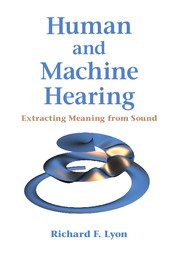Book contents
- Frontmatter
- Dedication
- Contents
- Foreword
- Preface
- Part I Sound Analysis and Representation Overview
- Part II Systems Theory for Hearing
- Part III The Auditory Periphery
- Part IV The Auditory Nervous System
- Part V Learning and Applications
- 24 Neural Networks for Machine Learning
- 25 Feature Spaces
- 26 Sound Search
- 27 Musical Melody Matching
- 28 Other Applications
- Bibliography
- Author Index
- Subject Index
- Plate section
24 - Neural Networks for Machine Learning
from Part V - Learning and Applications
Published online by Cambridge University Press: 28 April 2017
- Frontmatter
- Dedication
- Contents
- Foreword
- Preface
- Part I Sound Analysis and Representation Overview
- Part II Systems Theory for Hearing
- Part III The Auditory Periphery
- Part IV The Auditory Nervous System
- Part V Learning and Applications
- 24 Neural Networks for Machine Learning
- 25 Feature Spaces
- 26 Sound Search
- 27 Musical Melody Matching
- 28 Other Applications
- Bibliography
- Author Index
- Subject Index
- Plate section
Summary
In order for a digital neocortex to learn a new skill, it will still require many iterations of education, just as a biological neocortex does, but once a single neocortex somewhere and at some time learns something, it can share that knowledge with every other digital neocortex without delay. We can each have our own private neocortex extenders in the cloud, just as we have our own private stores of personal data today.
—How to Create a Mind, Ray Kurzweil (2012)Learning from Data
Just as our brains use learning as we develop the ability to interpret the world through patterns arriving on the auditory nerves, so can machines use learning to develop the ability to extract meaning from the sound representations extracted by auditory models.
The inputs that machines learn from are called data, and come in many forms. Sometimes we use supervised learning: training data associate sounds with answers, and the machine learns a model for that association, so that it will give good answers for novel sound data later. If we have lots of sound data, but no good answers to say what it means, we can still model the data and learn to produce compact meaningful descriptions and predictions of it, using unsupervised learning.
In this chapter we focus on supervised learning, and on artificial neural networks (ANNs or simply neural networks or neural nets) as a general class of techniques that were originally motivated by theories of how brains work. Neural nets and their descendants are widely employed in classification problems, where the answers are class decisions, and in regression problems, where the answers are continuous functions of the inputs. Our examples focus on classification.
The machine learning (ML) community discovered long ago that learning to get mostly right answers on a training set is not a safe goal for supervised learning. A system that models the training data well may get all the right answers on those, but still fail to generalize to independent testing data. So it is important to have an independent test set, and to use techniques that learn from the training data but generalize well to the independent testing data.
- Type
- Chapter
- Information
- Human and Machine HearingExtracting Meaning from Sound, pp. 419 - 440Publisher: Cambridge University PressPrint publication year: 2017
- 16
- Cited by

